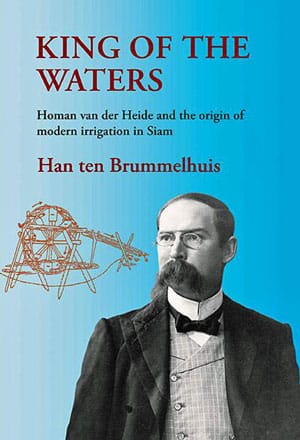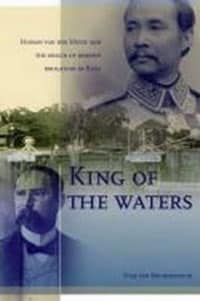Homan van der Heide carried the water to the sea

This visit was part of a European tour of the Siamese king, which also included Great Britain, Germany and Russia. The intention was not only to strengthen diplomatic ties with Western countries during this trip, but also to become acquainted with and gain insight into the most recent scientific discoveries and industrial achievements.
After all, Chulalongkorn was determined to propel Siam forward in the momentum of the nations and to steer his kingdom smoothly into the twentieth century. He was received with all due respect by the 17-year-old Queen Wilhelmina, who was still under regency. During this state visit, Chulalongkorn was deeply impressed by the Dutch hydraulic engineering works, such as the dikes, pumping stations and irrigation works that he was able to view during his visit.
Arranging and controlling water management was a problem that was not unfamiliar to the Siamese, especially in Bangkok. Just like the inhabitants of the Low Countries, the Siamese had been engaged in heroic struggles for centuries against the omnipotence of the water, which, just like in the Low Countries, was of vital importance to the economy and food production. At the express request of the Siamese court, a group of Dutch hydraulic engineers, led by chief engineer JH Homan van der Heide, came to help the Siamese build canals and locks between 1902 and 1909.
Homan van der Heide was a highly skilled engineer from Rijkswaterstaat who had graduated in Delft and had worked in the Dutch East Indies since 1894. One could say a lot about the man, but certainly not claim that he was being lazy. In the spring of 1903, less than a year after he first set foot in Bangkok on June 13, 1902, he had already, at the request of the Siamese Crown Council, read Chulalongkorn, the Department of Irrigation put on feet. An administrative and organizational feat that was followed with suspicion by the British, who would have liked to have carried out this job themselves, a matter of increasing their influence at the Siamese court. The anti-British resentment that the Dutch chief engineer harbored for the rest of his life probably originated here, because British engineers in Bangkok regularly tried to put him in the basket or to discredit him with his clients.
The British were by no means the only ones who were irritated by Homan van der Heide. He had, not entirely unjustly, the reputation of being quite full of himself and was also quite rigid in his performance. The pedantic raised Dutch finger was apparently of all times (5555). It is therefore not really surprising that he has stepped on a number of sensitive toes during his stay in Siam. And then I'm not even mentioning the covert and open envy of some senior Siamese officials and authorities who regard him as a pusher or worse, considered a threat.
After all, he had not only succeeded in setting up a well-functioning department in no time at all, but he had also succeeded in conducting an extensive field study for the entire basin of the Chao Praya, the lifeblood of Siam. This study resulted in a very ambitious plan called the Grand Model. A large-scale irrigation plan that not only had to irrigate 1902 hectares of land within a period of 10 years and largely transform it into fertile rice fields, but also had to provide the fast-growing Bangkok with the necessary drinking water. This plan provided, among other things, for the construction of a colossal dam at Chainat and the construction of a whole series of locks and additional drainage channels.
Ultimately, the plans for the Grand Model fell through. One of the main reasons for this was the lack of forceful action by the Minister of Agriculture Chao Phraya Thewet, who, partly because of the simple fact that he had no knowledge of the matter at all, did not see the large-scale and especially complex irrigation plans of the Dutchman. to sit. And then, of course, there was the cutthroat competition and rivalry of the Siam Land, Canals and Irrigation Company. A private company set up by the Austrian investor Erwin Müller shortly before the arrival of the Dutch engineers with the support of prominent Siamese senior officials and noblemen. This powerful consortium, known in the corridors as the Borisat whether 'The Company' was known, exerted a great deal of influence on government and court circles and managed to postpone or even prevent large parts of the Dutch plans. However, this does not mean that the work of JH Homan van der Heide has been unimportant, on the contrary. He not only cultivated the plans for new canals and locks, but also, despite the obstruction of some, left a substantial part of the existing canals and klongs renovate and expand in and near the capital.

Around 1920 Homan van der Heide settled in Maarssen aan de Vecht where he became one of the directors of the Kinine factory. In 1939 he was elected councilor for the Liberal state party 'de Vrijheidsbond'. He published regularly in the journal The engineer, the mouthpiece of the Royal Institute of Engineers (KIVI). When his friend and former colleague Anton Mussert turned fifty, Homan van der Heide published the book in 1944 with the NSB publisher Nenasu 'Mussert as an engineer'. His friendship with the NSB leader would cost him dearly. Immediately after the liberation, he was arrested and interned on charges of collaboration. He died on November 4, 1945 in an internment camp in Kampen.
For anyone who wants to know more about this remarkable engineer, this reading tip: In 2000 Silkworm Books published King of the Waters – Homan van der Heide and the origin of modern irrigation in Siam, an extremely readable and very detailed study by the Southeast Asian anthropologist Han Ten Brummelhuis (Amsterdam University) about this Dutchman, who is intriguing in more than one respect.


thanks didn't know about this. Implementing this plan might have greatly helped Bangkok in its ongoing battle against the floods…
Thanks Jan,
Good story.
Too bad it never came to fruition.
Now they still have wet feet 😉
Seems very interesting to me. As a Dutchman you often fantasize about “how things can be done differently”, especially when you see what that water is doing to BKK and the surrounding area.
During the war, Homan van der Heide was a nasty figure who gave shelter after Mad Tuesday to all that filthy scum such as the Rost van Tonningens. False elite.
In those years, rice was the most important export product and the tax on it was the most important income for the state.
Homan van der Heide wanted to increase rice yields through better irrigation.
His work had little to do with the prevention of flooding, in the aforementioned book by Han ten Brummelhuis that aspect is hardly mentioned.
On the contrary, farmers were usually happy with floods that increased the fertility of their land. Anything better than too little water.
In the book by Han ten Brummelhuis it says on page. 137 the following:
'Where flooding lasted the longest land sale and lease prices were highest.'
At that time, flooding was considered quite normal, sometimes too much and too long. They had houses on stilts and boats. Years with too little water was the problem.
Hi Tino,
I never claim that Homan van der Heide had the intention to prevent flooding. His irrigation plans were solely aimed at achieving the most profitable and responsible water management possible and indeed optimizing the rice harvest….
That's where Lung Jan. I was really just responding to a few people above who mentioned flooding. But what did you mean by 'Homan van der Heide carried the water to the sea'?
Hi Tino,
In a literal and figurative sense, he carried the water to the sea. Not only with the runoff and other water control works he edited, but after a while he must also have noticed - and perhaps to his growing frustration - that a good part of his efforts were in fact pointless because they were being countered signs by Siamese authorities and/or other stakeholders such as the quasi-omnipotent Borisat…
Homan v/d Heide is still talked about to this day, especially at RID and ONWR to whom they owe a lot and where Dutch water management is still on the list.
Many young people are studying in Delft.
Quote:
'To this day there is still talk of Homan v/d Heide, especially at RID and ONWR to whom they owe a lot and where Dutch water management is still on the list.'
Indeed. I think I once read that a statue of Homan van der Heide in the Irrigation Department in Bangkok is still honored.
The book “King of the Waters” was self-published as a doctoral thesis by Han ten Brummelhuis in 1995 with the title “De Waterkoning. J. Homan van der Heide, State formation and the origins of modern irrigation in Siam 1902-1909”. The English translation was published in 2005 by KITLV Press in Leiden and in 2007 by Silkworm in Chiang Mai.